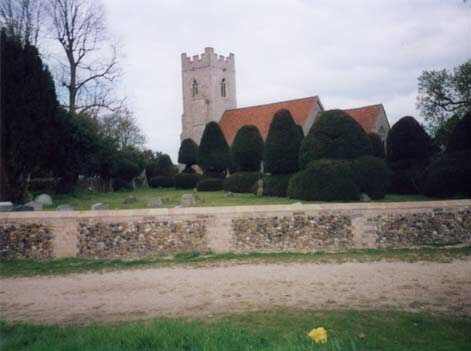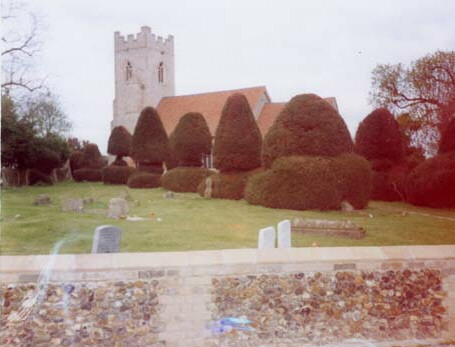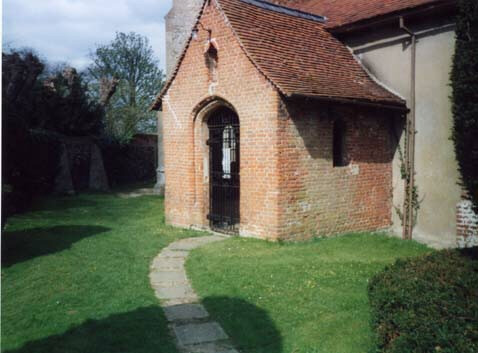

I have recently had a roll of film developed, from which I knew to have three photographs that I took at Borley on 9 April 2003. You may wish to scrutinize a strange form that has appeared on the bottom-left of my photograph. My wife brought it to my attention, and I "see" a head with longish hair looking right (along the side of the wall). I find it quite curious. I took the pictures with a Pentax c-33 camera with a 30mm lens. I have placed the pictures in chronological order-picture. #1 was taken at 09.03 am. Picture #2 10.15 am. Picture #3 at 11.57am. Regards,
Alexander MacDonald

 Picture #2 shows classic symptoms of "flare" where the
light is coming in at the wrong angle to the lens and you get "echo's". The
shape is probably an internal reflection within the lens of one of the
grave stones. The whole exposure of the photo is "flat" and has no
contrast, this supports the flare analysis. Have a look in any photography
text book and you will see a similar thing explained. The "floating" image
would be more plausible if the exposure was the same contrast as #1. If you
look on a map at the orientation of the church to the horizon and then work
out where the sun would have been at those times you will see how the flare
could have arisen. - Nick Rowland
Picture #2 shows classic symptoms of "flare" where the
light is coming in at the wrong angle to the lens and you get "echo's". The
shape is probably an internal reflection within the lens of one of the
grave stones. The whole exposure of the photo is "flat" and has no
contrast, this supports the flare analysis. Have a look in any photography
text book and you will see a similar thing explained. The "floating" image
would be more plausible if the exposure was the same contrast as #1. If you
look on a map at the orientation of the church to the horizon and then work
out where the sun would have been at those times you will see how the flare
could have arisen. - Nick Rowland
Very strange. There is definately some sort of exposure on the picture. It is easy to speculate but I cannot comment on what it is or how it got there. Is it double exposure? Is it a reflection of some sort? A few years ago, I took pictures in the snow on ordinary film on a gloomy day. When the pictures were developed, small very bright figures a few millimetres high appeared. I don't know if it is some sort of energy or whether something went wrong in the developing process. - Robert Vajna
I find this interesting. I read both [previous] comments on the web site and I don't know that I agree with Nick Rowland (with utmost respect, of course). The image lacks blue and is overall too red. I'm not convinced that the hazy image and what's next to it are due to lens flare. If so, it seems both of these images would have the same hue as the rest of the photographic print. However, I'm one who buys printing for a living and I know that ink on paper differs from emulsion, but it seems that the same basic color principles would apply. I'm interested in reading other thoughts! It could be wishful thinking, on my part, and our eyes do play tricks... And our minds even more! - Karen Zimmerman
Indeed (with a little bit of suggestion) a transparent and partially veiled head is visible. Personally I agree with Nick Rowland's analysis. His analysis could be supported by the bluish object in the lower middle of the picture (a further light effect?) as well as that this particular photograph has a rather strong inclination towards the colour red (compared to picture no. 1). Just a thought - has the picture no. 2 been taken from the inside of a car (through a closed window)? - Best regards from Switzerland, Andreas Trottmann [I was on foot. - A.M.]
I especially like the one of the entrance, You can really see the age there. - Kathy Rageur
I tend to agree with Nick Rowland's assessment of the Alexander MacDonald's picture. I can see what Alexander means by "a head with longish hair" but if there is a face on the "head", I can't see it. Therefore, it's the "hair" alone that suggests a "head" and, acutally, the strands of "hair" are an unusually wide distance apart from one another. I took a closer look at the picture with various filters, light changes, etc. but nothing extra was revealed - although a high-resolution close-up of the area might help with further investigation. The long and short of it is that this picture is one of those which some people will say shows "something" while others will say it shows "nothing" With best wishes - Stephen D. Smith